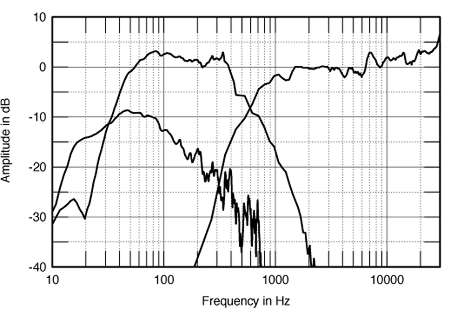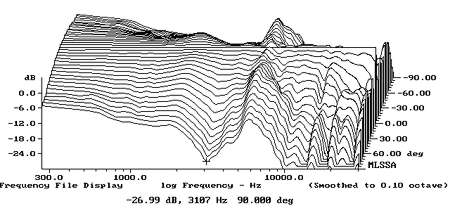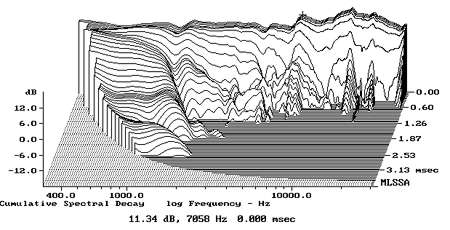| Columns Retired Columns & Blogs |
Piega C8 LTD loudspeaker Measurements
Sidebar 3: Measurements
Its measured sensitivity of 86dB(B)/2.83V/m makes the Piega slightly below the average for the speakers I have measured over the past 13 years. Its impedance (fig.1) also drops to 3 ohms in the midbass, which means that it will need to be used with a good current-capable amplifier. The traces in fig.1 are free from the wrinkles that would indicate panel resonances, and investigating the aluminum-sheathed cabinet's vibrational behavior with an accelerometer revealed a well-behaved design, with only a low-level mode at 350Hz evident near the top of the side panel (fig.2) and on the top panel.

Fig.1 Piega C8 LTD, electrical impedance (solid) and phase (dashed). (2 ohms/vertical div.)

Fig.2 Piega C8 LTD, cumulative spectral-decay plot calculated from the output of an accelerometer fastened to the cabinet's side panel 8" from the top. (MLS driving voltage to speaker, 7.55V; measurement bandwidth, 2kHz.)
The speaker reflex-loads its three woofers with a port on the front baffle; fig.1 suggests this is tuned to 42Hz. However, the nearfield responses of the port and woofer (fig.3, left-hand traces) suggest that while the port output does peak broadly at this frequency, it is actually tuned an octave lower—the woofers' minimum-motion point occurs at 20Hz. Even so, the port doesn't do much about extending the speaker's low-frequency response, but probably is more important in relieving the woofers of having to undergo large excursions in their bottom octave. The port response rolls off fairly smoothly above 80Hz.

Fig.3 Piega C8 LTD, acoustic crossover response on tweeter axis at 50", corrected for microphone response, with nearfield responses of the woofer and port plotted below 300Hz and 800Hz, respectively.
The woofers' passband extends from 40Hz to 600Hz, with a smooth, fourth-order rollout above that range. Rolling in above 600Hz, the midrange/tweeter panel has a basically flat response, but with an on-axis rise apparent above 8kHz (fig.3, right-hand traces). This rise disappears rapidly to the speaker's sides, so that averaging the C8 LTD's output across a 30 degrees horizontal window results in a very flat response from the middle of the midrange to well above the top of the audioband (fig.4). In the bass, most of the apparent boost evident in fig.4 is due to the nearfield measurement technique. The quasi-anechoic extension appears modest, at -6dB at 40Hz, but this will be usefully increased in-room by the usual boundary reinforcement to give a good balance of mid-bass weight and definition. Nevertheless, as LG mentioned in his auditioning comments, the C8 LTD is not a speaker for low-bass freaks.

Fig.4 Piega C8 LTD, anechoic response on tweeter axis at 50", averaged across 30 degrees horizontal window and corrected for microphone response, with the complex sum of the nearfield responses, taking into account acoustic phase and distance from the nominal farfield point, plotted below 300Hz.
The relatively large tweeter element of the ribbon is quite directional; its output begins to roll off if you sit more than 5 degrees above or below the tweeter axis (fig.5). The midrange element of the panel also gets directional at the top of its passband, which can be seen in the plot of the C8 LTD's horizontal dispersion (fig.6). The response at 3kHz is down more than 24dB at 90 degrees off-axis, yet is much higher in level an octave higher, where the signal is handled by the tweeter. Predicting the subjective effect of this behavior is difficult; it will depend on the proximity of the sidewalls and how absorbent they are whether the off-axis notch is heard as a loss of dynamic impact or the subsequent flare is heard as brightness. Other than this notch and flare in the presence region, and the tweeter's sharp directionality above 10kHz, the Piega's radiation pattern is relatively even.

Fig.5 Piega C8 LTD, vertical response family at 50", normalized to response on tweeter axis, from back to front: differences in response 15 degrees-5 degrees above axis, reference response, differences in response 5 degrees-10 degrees below axis.

Fig.6 Piega C8 LTD, lateral response family at 50", normalized to response on tweeter axis, from back to front: differences in response 90 degrees-5 degrees off-axis, reference response, differences in response 5 degrees-90 degrees off-axis.
The Piega C8's step response on the tweeter axis (fig.7, black trace) is complex, so I have overplotted the individual steps of the woofers (blue) and of the midrange/treble panel (red). All the drive-units are connected in positive acoustic polarity, but the speaker is not time-coherent. Although the ribbon is flat, the output of the tweeter section arrives first at the microphone, followed within 0.1ms or so by that of the coaxial midrange section, this presumably delayed a little by the crossover. The output of the woofers arrives a millisecond later, coinciding with the positive-going return to the time axis of the midrange step, which confirms the good frequency-domain integration of the drivers seen in fig.4.

Fig.7 Piega C8 LTD, step response on tweeter axis at 50", with that of the woofers (blue) and midrange/tweeter panel (red) plotted separately (5ms time window, 30kHz bandwidth).
The C8's cumulative spectral-decay, or waterfall, plot (fig.8) mainly shows the behavior of the midrange/tweeter panel. Yes, there are hints of some delayed energy at 7kHz and 18kHz; otherwise, it is superbly clean.

Fig.8 Piega C8 LTD, cumulative spectral-decay plot at 50" (0.15ms risetime).
All in all, the Piega C8 LTD is a well-engineered loudspeaker that successfully marries its conventional moving-coil woofers to a unique coaxial ribbon unit for the midrange and treble.—John Atkinson
- Log in or register to post comments




































